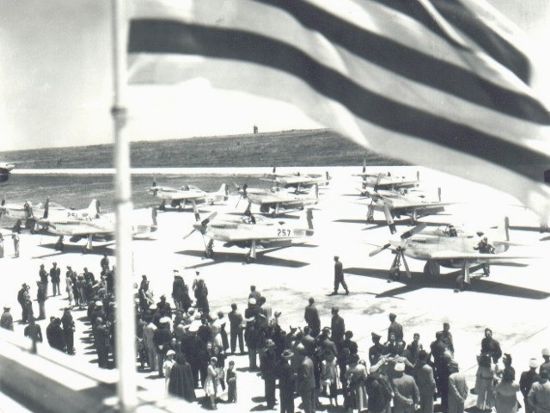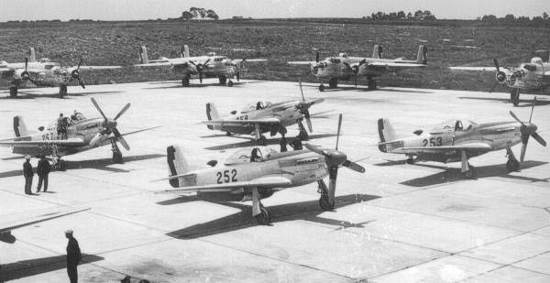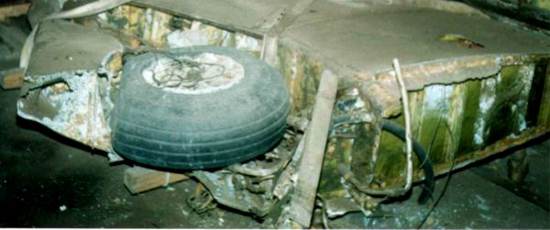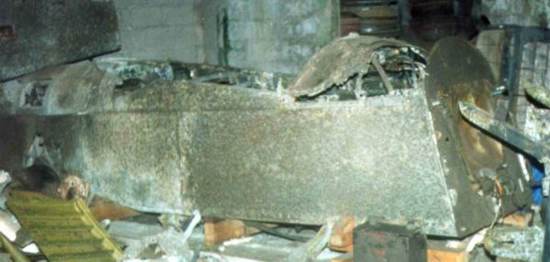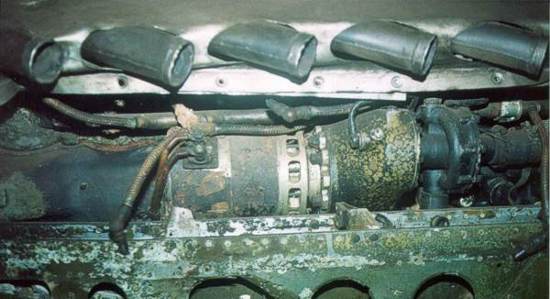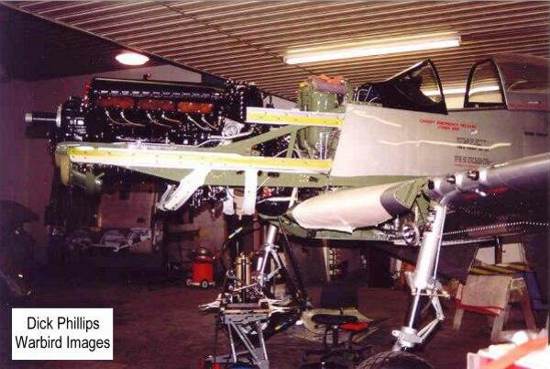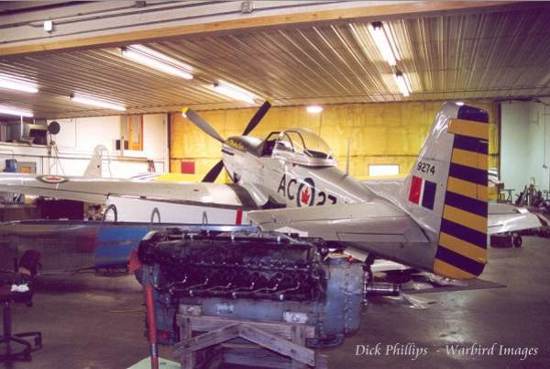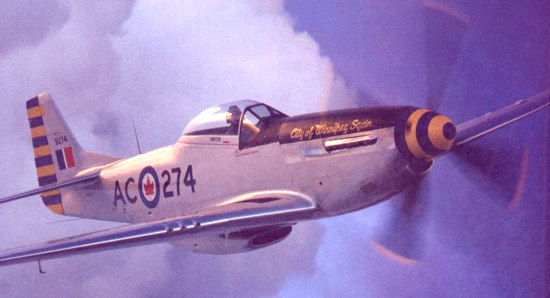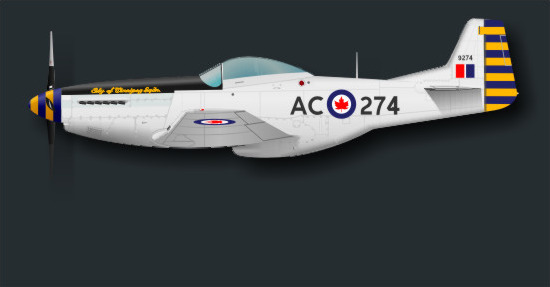|
Mustang FAU 252: the airplane that would not die
December 4, 1950. F-51 Mustang reception ceremony.
The North American F-51D Mustangs arrived in Uruguay in three groups. The first one, the Red Group, arrived in November 22, 1950. The Blue Group arrived the 24th of the same month. Finally, the White Group landed in Carrasco on December 4, 1950. Those 23 airplanes, along with other two arrived by boat, made up the 25 bought by the Uruguayan government, together with 11 B-25J bombers and 3 C-47 transport aircraft. The political situation in the neighbouring Argentinean Republic, forced Uruguay to strengthen its military defense.
Among these Mustangs there was an airplane with the original serial number 44-63476 from the USAAF (United States Army Air Forces), that received the Fuerza Aérea Uruguaya’s identifying plate 252. On August 8, 1955, during a real-fire shooting exercise, the FAU 252 crashed in the Rincón del Bonete Lake, killing its pilot and dissapearing beneath the surface of the lake. It was the F-51’s first fatal accident in Uruguay.
Learnings from the past Almost 20 years later, flying T-33, the
memory of such accident lived in each and every briefing before the real-fire
shooting exercises.
Flying Times Memories Thirty years later, our flight is "virtual". We "fly" through the Internet in a self-imposed mission of recovering those graphic and sound materials that remind us of the planes we flew, and those histories that remind us of those with whom we flew. And those person’s routes constantly intersect, shortening distances, easier than flight itself... One day I received an email from someone called P. Thomasett, in which he wrote:
Noticing that he did not completely know his uncle's crash history, that the flight that ended in that crash had taken off from Carrasco, I replied with the following message:
Two days later, Lt. Jorge Thomasset nephew's thanked me for "this memory of an uncle I never knew", as he e-mailed me his pictures registering the remainings of the F-51 Mustang FAU 252, that was recovered in 1994, from the bottom of Rincón del Bonete lake. The goal of a lifetime
Bob May was born in Canada, halfway through the 20th century, and was raised in a farm, not far away from a small Royal Canadian Air Force airfield, that contained the wrecks of several F-51 Mustang, that where once part of the RCAF City of Winnipeg 402 Fighter Bomber Squadron. Bob remembers around 15 Mustangs in the field, most of them would be afterwards sold to US for being recovered, where they are flying today.
In the mid 60´s in their regular visits to the airfield with the purpose of buying bricks that were sold there, Bob's father had to constantly say no to his son's request of purchasing on of those wonderful planes, that where sold for 500 dollars each. These visits to the Carberry airfield where Bob May´s first contact with aviation, and sealed his destiny. Eventually, Bob become a proffesional pilot flying over Northern Canad to perform supplying missions for those remote areas accesible only by air. Later on he started his own air company, Keewatin Air, which initially operated Beavers and Cessnas 185.
But Bob never stopped thinking about the Mustangs. Every once in a while he checked for adquiring one of these aircraft, finding out that they were not longer sold at 500 dollars but 25000. And when he thought he had the necesary money to buy one of them, he discovered that the price tag was 125.000, and eventually more, always being out of his reach. Nevertheless, Bob decided he would own a Mustang, and for that he would have to build it himself. Fau 252 search and rescue From 1990 on, Bob began adquiring F-51 parts through Trade-A-Plane and by phone. He finally made contact with Rocky Medina, a californian that had localized in Uruguay a Mustang which was possible to recover from the bottom of the lake where it had crashed in 1955, killing its pilot. This plane was the FAU 252, and its pilot was Liutenant Jorge Thomasset. After reading about FAU 252 in a book about latinamerican Mustangs, Medina had travelled to Uruguay and obtained, after long negotiations with the Uruguayan Air Force, the right to rescue the Mustang wreck from the bottom of the lake. An even bigger obstacle had been the widow of teh deceased pilot, wich had not married again. The tragic accident had happened shortly after their wedding, and the old lady was still in love with his young liutenant. Eventually, her consent was achieved.
A partir de 1990, Bob comenzó a comprar partes de F-51 a través de Trade-A-Plane y del teléfono. Finalmente se contactó con Rocky Medina, un californiano que había localizado en Uruguay, un Mustang que eventualmente era posible recuperar del fondo del lago donde se había estrellado en agosto de 1955, matando a su tripulante. Era el FAU 252 y el piloto era el Teniente Jorge Thomasset. Tras haber leído en un libro sobre Mustangs latinoamericanos sobre el FAU 252, Medina había viajado al Uruguay, y obtenido, tras largas negociaciones con la Fuerza Aérea Uruguaya, los derechos de rescate de los restos del Mustang del fondo del lago. Un obstáculo mayor había sido la obtención de la anuencia de la viuda del piloto fallecido, la que no había vuelto a casarse. El trágico accidente se había producido muy poco después de su boda, y aún anciana, continuaba enamorada de su joven teniente. Pero, finalmente, también se obtuvo su consentimiento.
In his trips to Uruguay, Medina had known a woman who claimed to know exaclty where the wreckage of FAU 252 was, Bob and Rocky started their search in the place indicated by her, trusting they would achieve their objective in a few days. So confident they wear, that Bob En sus viajes al Uruguay, Medina había conocido a una mujer que aseguraba saber con exactitud el lugar donde estaban sumergidos los restos del FAU 252. Bob y Rocky comenzaron su búsqueda en el lugar por ella indicado, confiados en que lograrían su objetivo en unos pocos días. Tanta confianza tenían, que la primera expedición al Uruguay, Bob la realizó con toda su familia. Se alojaron en la ciudad de Paso de los Toros, a la que recuerda como un pequeño pueblo dedicado a la ganadería. Cuenta Bob que se alojaron en el mejor hotel de la ciudad, pagando 3 dólares por noche, por una habitación con puerta corrediza... Sus hijos bromeaban con el nombre del pueblo, señalando que no debía ser Plaza de los Toros, (así lo habían captado), sino Plaza de los Turistas Perdidos, ya que eran los únicos de tal condición en el lugar... Inciadas las operaciones de búsqueda, la gente del pueblo, descripta por Bob May como muy amable, demostró su curiosidad por saber qué estaba ocurriendo. Según Bob, algún grupo identificado con los postulados de Greenpeace, decidió que el gobierno había planeado la instalación de una Central de Energía Nuclear en la zona, y que las actividades de los canadienses eran estudios conducentes a esos propósitos. Pese a las explicaciones de Bob y Medina sobre que la razón era el rescate de un avión sumergido, la observación del equipo de sonar y el magnetómetro utilizados en la búsqueda de los restos, solamente sirvieron para confirmaran la versión de que equipo de última tecnología se estaba utilzando para estudiar las posibilidades de las aguas del Río Negro para el enfriamiento de la supuesta planta nuclear. Se necesitaron varios viajes y más de un año, para finalmente encontrar los restos del avión, a tres millas del lugar indicado por la testigo. Es posible que el dato proporcionado por la testigo fuera exacto, y que el avión se hubiera desplazado flotando llevado por la corriente. Estaba a una profundidad de 20 metros.
The rescue These pictures show the incredible state of conservation of the remainings of the aircraft, probably due to the fact that it was buried in the bottom of the lake, protected by the mud from the destructive action of oxygen.
Part of the middle plane of FAU 252, wheel and tire, in exceptional state of conservation.
Upper part of the fuselage
Exceptional state of the exhaust pipes and ignition cables.
Engine commands and flight surface compensators. These remains of FAU 252 were taken to the United States for their reconstruction. The main fuselage structure had little damage, and what for the reconstruction purposes is most important, the original data plate that identifies the airplane, had been recovered.
Ready to fly again. Bob May is the new owner of FAU 252. He is an experienced restorer of those planes called "Warbirds". The reborn P-51D 20NA, with its serial number 44-63476, has a new USA registration N63476, and has been named "City of Winnipeg Sqdn.", honoring and old RCAF (Royal Canadian Air Force) P-51 squadron, the 402. It has been repainted with the 402 original color scheme.
The workshop were it has been rebuilt is located in Whapeton, ND, close to the canadian region of Manitoba, where 402 squadron had its base.
Fifty years after crashing in Rincón del Bonete Lake. FAU 252, now N63476 City of Winnipeg Squadron, is flying again.
Paul Bowen photo in WARBIRD DIGEST #6 winter 2005, via Gary Khun, Eduardo Luzardo, Wilman Fuentes
This Mustang stays in the course of fulfilling its destiny: TO FLY. Pilotoviejo
Sources:
Spanish original to english translation: Andrés Cobas Edition and revision: Tulio Soto - LAAHS
|

